PUBLIC FACILITY
COMPETITION FOR THE CONSTRUCTION OF A POLICE HEADQUARTERS AND 27 STAFF HOUSING UNITS.
TEAM
Lead Architect: Bruneau Ghezzi Architects Paris
Technical Design Firm: OTEIS
Acoustician: Acoustique & Conseil
Location: Venelles (13), France
Area: 8528 m2
Budget: €7 million
Client: Venelles Town Hall (13)
The Site’s Stone: The Identity of a Region
The project is situated on a limestone massif overlooking the town of Venelles: the Faurys ridge. This limestone rock forms the topography of the region and shapes the landscapes of Provence. It has been used for millennia for its durability, as evidenced by the Roman aqueducts and fortifications, which are part of our regional heritage. Today, it still adorns modern cities in Provence. Thus, it constitutes the regional built heritage and can be used at all scales, both at ground level and in elevation: from roadworks to street paving, as well as in construction or cladding stone. This symbolic stone of the territory composes the ground of our site and will be our material of choice to build and shape this project for the following reasons:
– It is emblematic, shaping and constructing the landscapes of the region.
– It integrates perfectly into both built and natural landscapes.
– It can be used in various forms and applications for construction.
– It embodies historical fortifications and facilities, naturally imparting an institutional aspect to the Police Headquarters.
– It will mark the city entrance with nobility and sobriety.
– It is locally sourced, utilizing regional craftsmanship.
– It is durable and requires no maintenance.
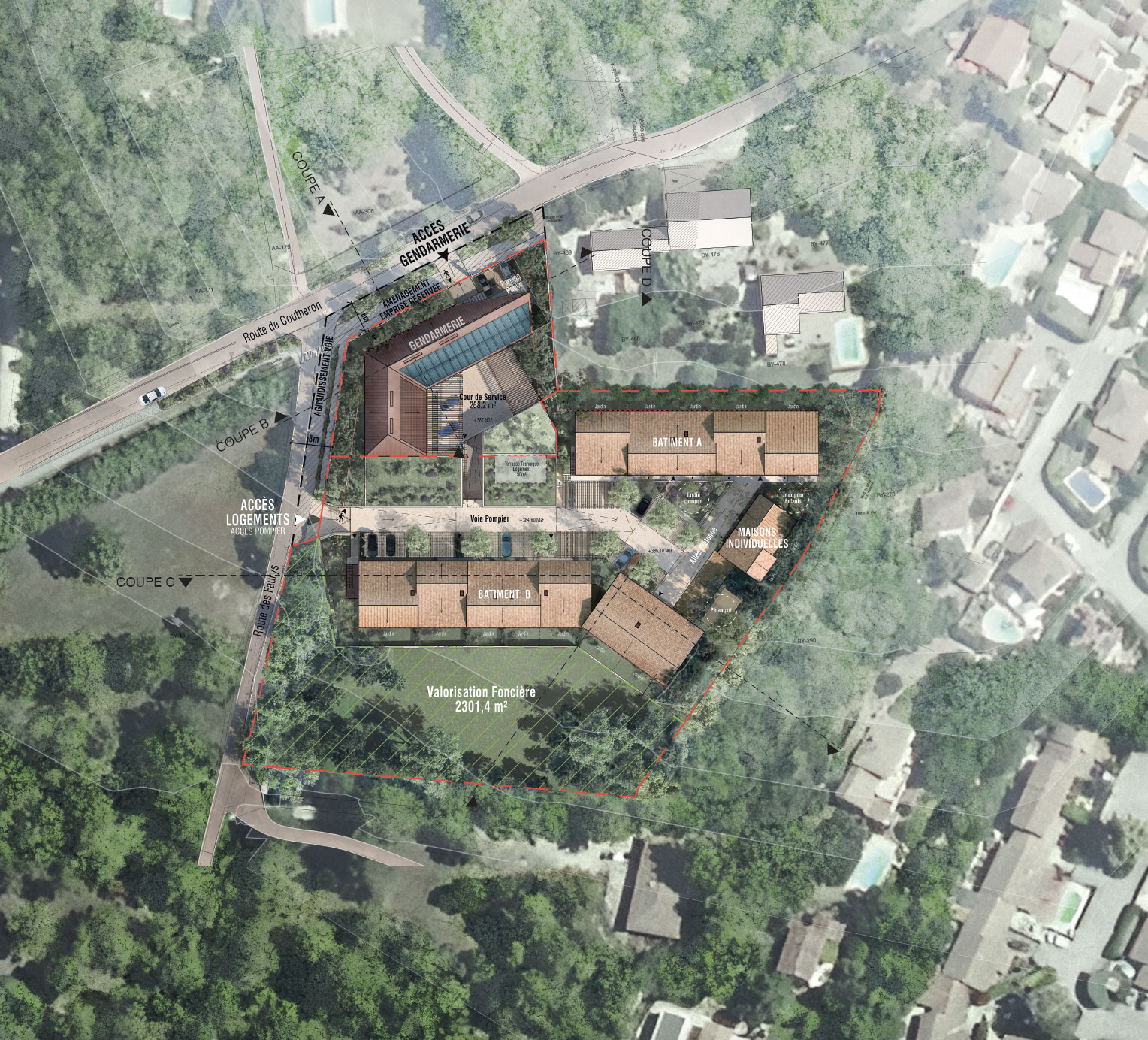
PUBLIC FACILITY
COMPETITION FOR THE CONSTRUCTION OF A POLICE HEADQUARTERS AND 27 STAFF HOUSING UNITS.
TEAM
Lead Architect: Bruneau Ghezzi Architects Paris
Technical Design Firm: OTEIS
Acoustician: Acoustique & Conseil
Location: Venelles (13), France
Area: 8528 m2
Budget: €7 million
Client: Venelles Town Hall (13)
The Site’s Stone: The Identity of a Region
The project is situated on a limestone massif overlooking the town of Venelles: the Faurys ridge. This limestone rock forms the topography of the region and shapes the landscapes of Provence. It has been used for millennia for its durability, as evidenced by the Roman aqueducts and fortifications, which are part of our regional heritage. Today, it still adorns modern cities in Provence. Thus, it constitutes the regional built heritage and can be used at all scales, both at ground level and in elevation: from roadworks to street paving, as well as in construction or cladding stone. This symbolic stone of the territory composes the ground of our site and will be our material of choice to build and shape this project for the following reasons:
– It is emblematic, shaping and constructing the landscapes of the region.
– It integrates perfectly into both built and natural landscapes.
– It can be used in various forms and applications for construction.
– It embodies historical fortifications and facilities, naturally imparting an institutional aspect to the Police Headquarters.
– It will mark the city entrance with nobility and sobriety.
– It is locally sourced, utilizing regional craftsmanship.
– It is durable and requires no maintenance.

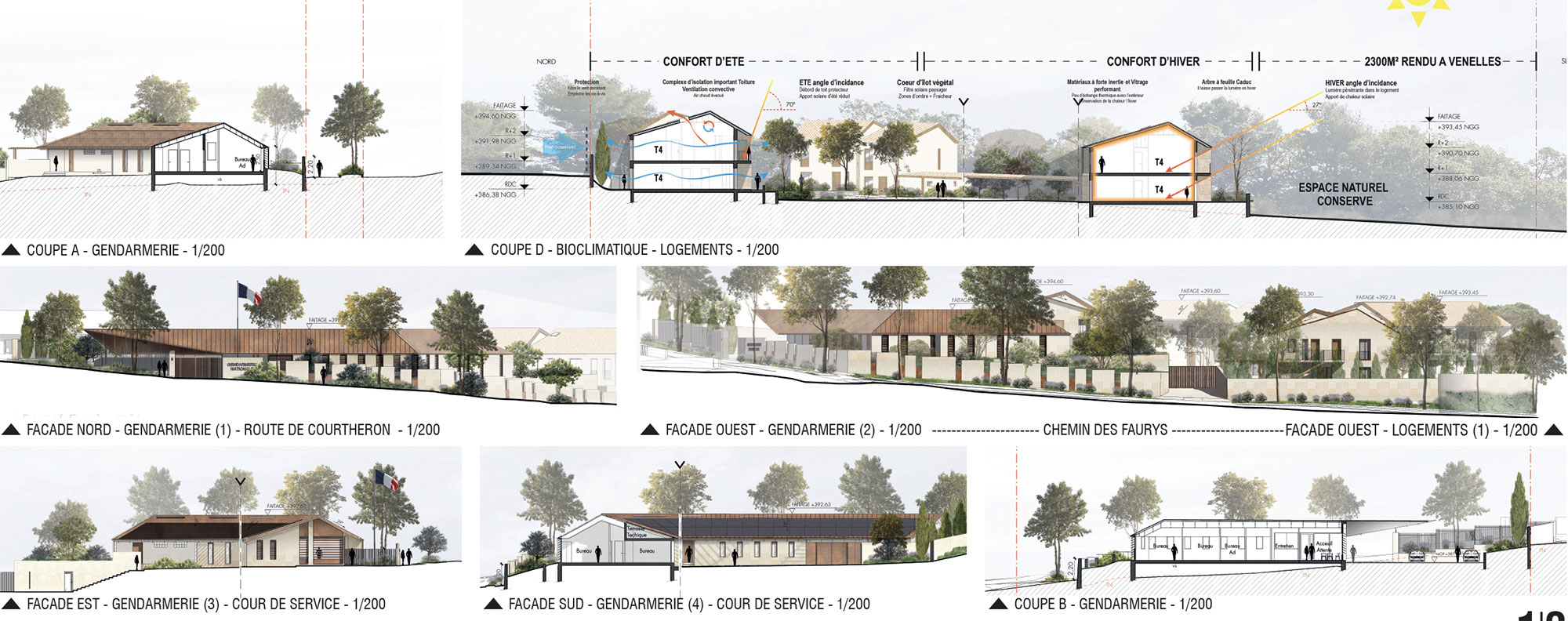
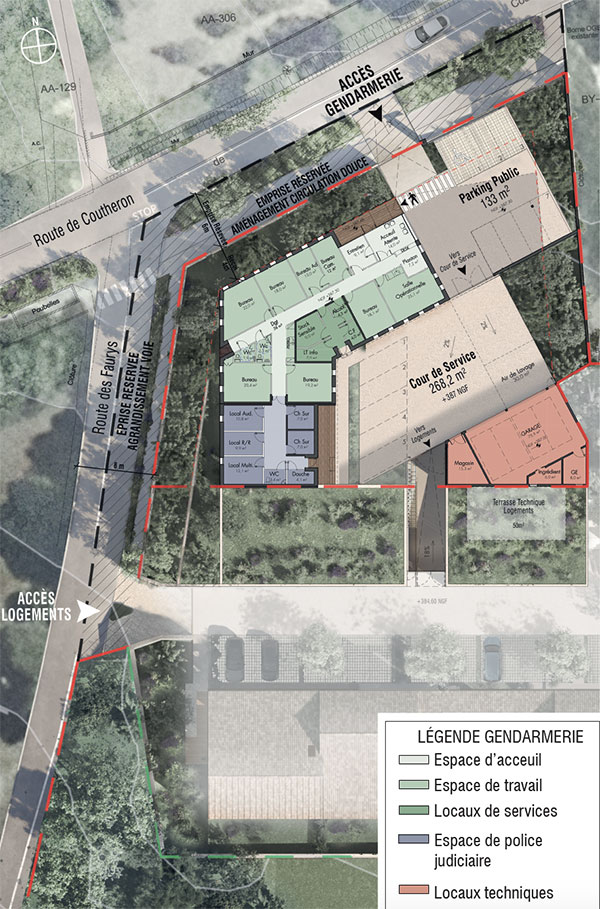
A Gateway to the City
The proposed site for the barrack is ideally located at the city entrance, overseeing a crossroad, with excellent visibility for anyone entering or leaving Venelles from the Coutheron road. The barrack is situated on the abundantly wooded Faurys ridge; such topography creates a natural barrier on the eastern side of the plot.
We have chosen to underline the military character of the construction by drawing inspiration from Vauban’s fortifications, creating a massive defensive architecture in limestone with a vegetated fortified enclosure. Through this principle, we have worked on distancing the gendarmerie building from its surroundings by planting this enclosure.
The project also takes advantage of the slope of the land overlooking the Faurys path. This ensures the security and confidentiality of the site regarding the public space and neighboring properties. Finally, this massive architecture and its monolithic aspect punctuated by windows with varying heights resonate with a recognizable military identity for the users.
The gendarmerie (barrack), through its location and architecture, evokes a fortified enclosure marking the city entrance. It marks the corner of the crossroad by its positioning. The setback of the building from the Faurys path and the Coutheron road preserves the continuity of vegetation masses along the roads. It allows for the future creation of pedestrian-friendly spaces along these roads, as desired by the municipality. This layout structures the crossroad and makes the project visible and easily recognizable from the public space.
A Protected Provençal Hamlet
The entrance to the residential part of the barrack is from the Faurys path. For this aspect of the project, more than just a place of residence, we like the idea of creating a Provençal hamlet. Similarly, the gendarmerie also marks the entrance to the military village. The project aims to free up common landscaped spaces in the center of the buildings, protected by them, for families. This liberated space in the heart of the plot allows for distance between the housing and the barrack, minimizes overlooking, and ensures the privacy and security of the residents.

A Gateway to the City
The proposed site for the barrack is ideally located at the city entrance, overseeing a crossroad, with excellent visibility for anyone entering or leaving Venelles from the Coutheron road. The barrack is situated on the abundantly wooded Faurys ridge; such topography creates a natural barrier on the eastern side of the plot.
We have chosen to underline the military character of the construction by drawing inspiration from Vauban’s fortifications, creating a massive defensive architecture in limestone with a vegetated fortified enclosure. Through this principle, we have worked on distancing the gendarmerie building from its surroundings by planting this enclosure.
The project also takes advantage of the slope of the land overlooking the Faurys path. This ensures the security and confidentiality of the site regarding the public space and neighboring properties. Finally, this massive architecture and its monolithic aspect punctuated by windows with varying heights resonate with a recognizable military identity for the users.
The gendarmerie (barrack), through its location and architecture, evokes a fortified enclosure marking the city entrance. It marks the corner of the crossroad by its positioning. The setback of the building from the Faurys path and the Coutheron road preserves the continuity of vegetation masses along the roads. It allows for the future creation of pedestrian-friendly spaces along these roads, as desired by the municipality. This layout structures the crossroad and makes the project visible and easily recognizable from the public space.
A Protected Provençal Hamlet
The entrance to the residential part of the barrack is from the Faurys path. For this aspect of the project, more than just a place of residence, we like the idea of creating a Provençal hamlet. Similarly, the gendarmerie also marks the entrance to the military village. The project aims to free up common landscaped spaces in the center of the buildings, protected by them, for families. This liberated space in the heart of the plot allows for distance between the housing and the barrack, minimizes overlooking, and ensures the privacy and security of the residents.
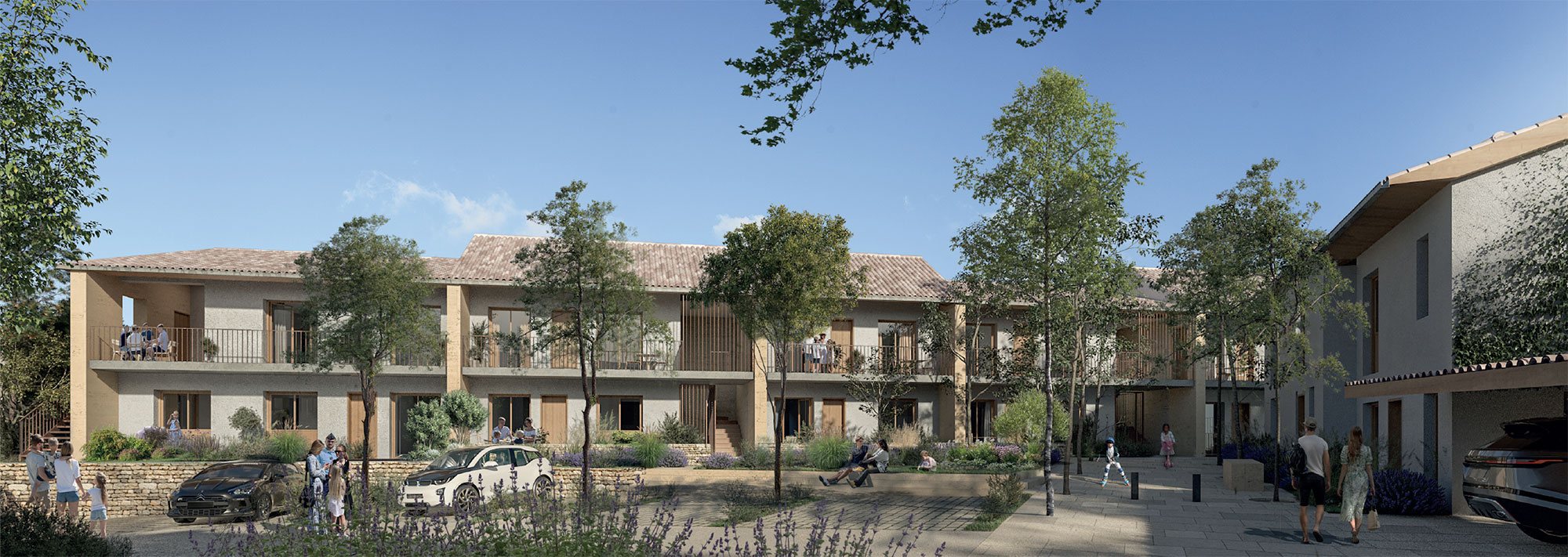
From the entrance of the barrack (located on the Faurys path), a road efficiently serves both the different parking areas and all the housing buildings. The village center consists of communal gardens, a central garden, a planted pedestrian alley, children’s play areas, and a “pétanque” court. A paved alley distributes the different residential areas and connects the shared living spaces. The heart of the courtyard blends vegetated and mineral spaces in the shade of trees, creating a gentle transition and allowing for various uses: games, cycling, organizing collective barbecues, etc. The groundwork, building placements, and pathways are arranged with gentle slopes, making them easily accessible to all.
To maintain the sense of an alcove inherent to the site, the placement of the housing buildings to the north, south, and east creates an intimate protected space, with an inward orientation at the center of the project, avoiding overlooking from neighboring plots. All semi-collective housing units located to the north are positioned against the prevailing winds of the site, once again to protect the central heart of the block.
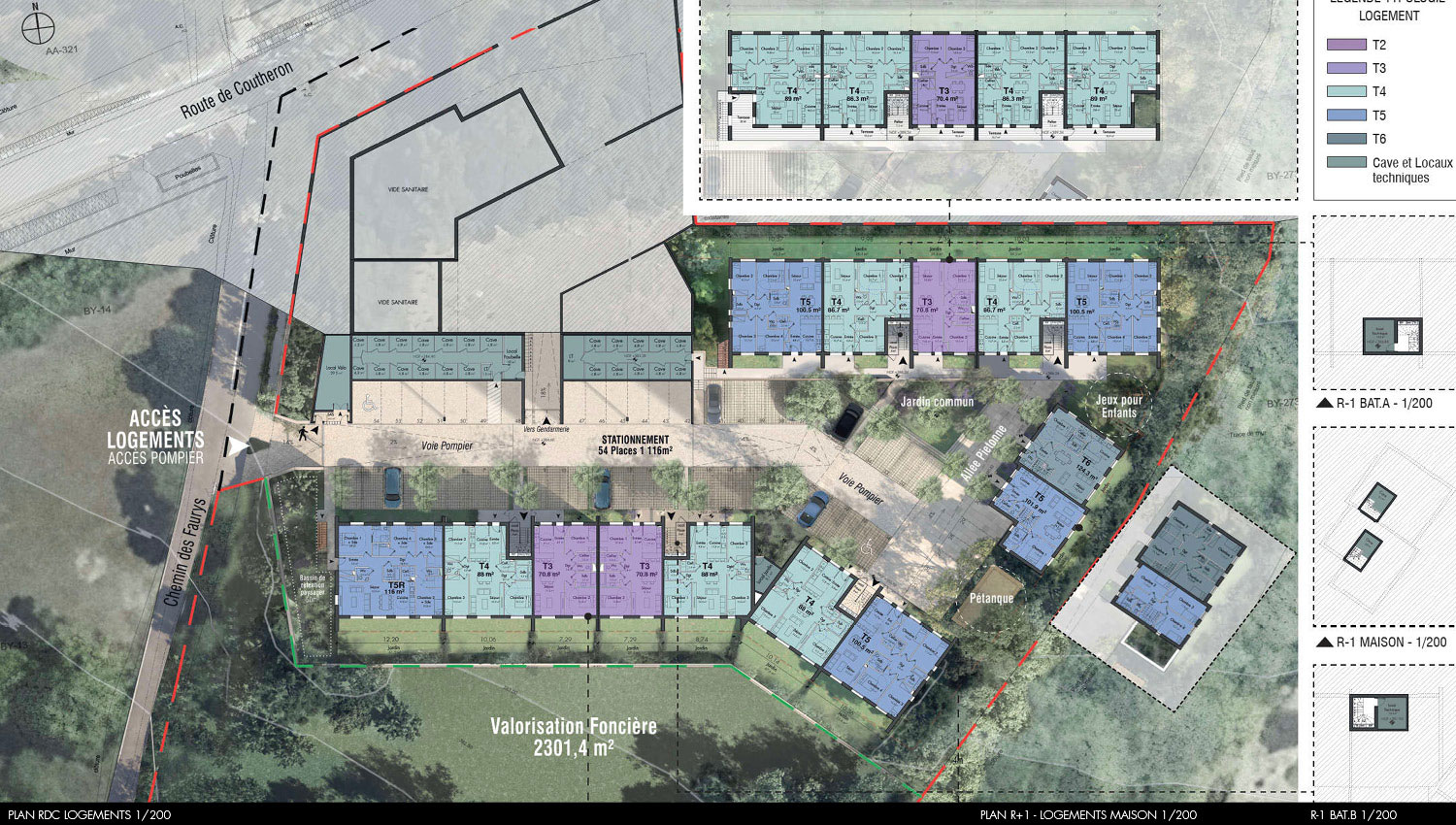
From the entrance of the barrack (located on the Faurys path), a road efficiently serves both the different parking areas and all the housing buildings. The village center consists of communal gardens, a central garden, a planted pedestrian alley, children’s play areas, and a “pétanque” court. A paved alley distributes the different residential areas and connects the shared living spaces. The heart of the courtyard blends vegetated and mineral spaces in the shade of trees, creating a gentle transition and allowing for various uses: games, cycling, organizing collective barbecues, etc. The groundwork, building placements, and pathways are arranged with gentle slopes, making them easily accessible to all.
To maintain the sense of an alcove inherent to the site, the placement of the housing buildings to the north, south, and east creates an intimate protected space, with an inward orientation at the center of the project, avoiding overlooking from neighboring plots. All semi-collective housing units located to the north are positioned against the prevailing winds of the site, once again to protect the central heart of the block.

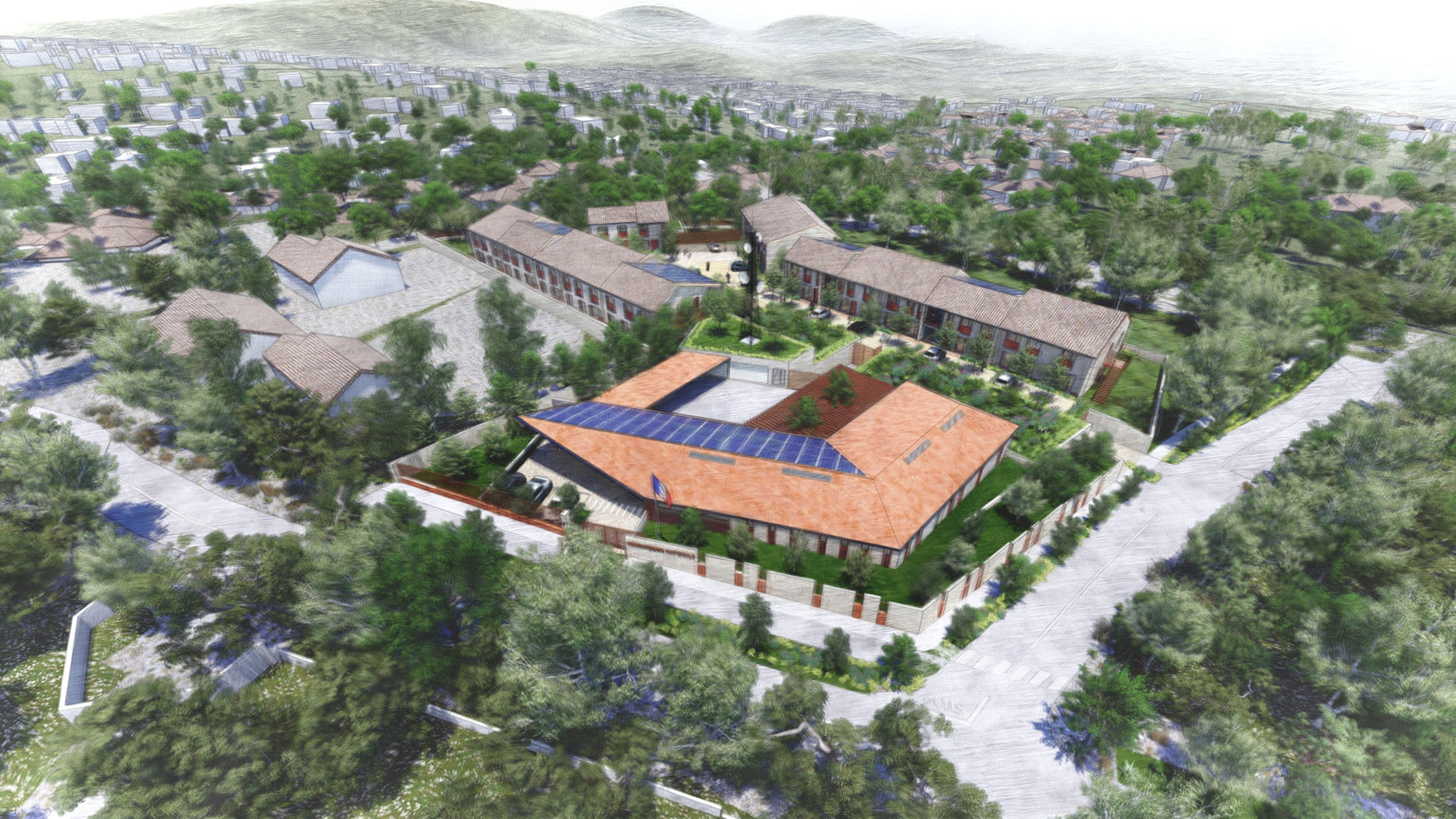
Bioclimatic, Rational, and Comfortable Buildings
The housing buildings follow the natural level curves of the site. The units, all except for one T2 apartment, are oriented north-south in continuity with the surrounding urban fabric and in compliance with the Venelles Urban Plan.
The proposed volumes, single-story for the gendarmerie and one-story for the housing, are rational, orthogonal volumes, naturally lit, and ventilated. These are easy to furnish and adaptable. The planned volumes and typologies stack perfectly between the two levels of the project to facilitate the distribution and maintenance of networks.
To provide better comfort for users while reducing future energy needs, the overall project of the barrack has been designed according to the principles of passive design, exploiting all available natural energies and processes.
Natural ventilation is defined as the most important principle of bioclimatic architecture, particularly in regions like Provence, where summer comfort is a priority. Wind naturally cools the building. The approach to bioclimatic architectural design involves designing the envelope considering the sun and wind, as well as temperature and humidity characteristics. Objective: to create a pleasant microclimate throughout all seasons.
– Promote natural ventilation.
– Limit heat gains in summer and maximize them in winter
– Exploit possibilities for natural lighting
– Respect internal comfort limits of the building
– Work on Hygrometry
The organization and placement of the housing systematize traversing typologies, which favor air circulation and cooling on building depths not exceeding 12 meters. This depth, coupled with dual orientation, ensures excellent interior brightness, and will easily facilitate its reversibility in case of reuse.
Bioclimatic design in Provence presupposes effectively managing solar gains, regardless of the season. We worked on generous roof overhangs and balconies on the south facades to avoid summer solar radiation and capture it in winter.
Bioclimatic, Rational, and Comfortable Buildings
The housing buildings follow the natural level curves of the site. The units, all except for one T2 apartment, are oriented north-south in continuity with the surrounding urban fabric and in compliance with the Venelles Urban Plan.
The proposed volumes, single-story for the gendarmerie and one-story for the housing, are rational, orthogonal volumes, naturally lit, and ventilated. These are easy to furnish and adaptable. The planned volumes and typologies stack perfectly between the two levels of the project to facilitate the distribution and maintenance of networks.
To provide better comfort for users while reducing future energy needs, the overall project of the barrack has been designed according to the principles of passive design, exploiting all available natural energies and processes.
Natural ventilation is defined as the most important principle of bioclimatic architecture, particularly in regions like Provence, where summer comfort is a priority. Wind naturally cools the building. The approach to bioclimatic architectural design involves designing the envelope considering the sun and wind, as well as temperature and humidity characteristics. Objective: to create a pleasant microclimate throughout all seasons.
– Promote natural ventilation.
– Limit heat gains in summer and maximize them in winter
– Exploit possibilities for natural lighting
– Respect internal comfort limits of the building
– Work on Hygrometry
The organization and placement of the housing systematize traversing typologies, which favor air circulation and cooling on building depths not exceeding 12 meters. This depth, coupled with dual orientation, ensures excellent interior brightness, and will easily facilitate its reversibility in case of reuse.
Bioclimatic design in Provence presupposes effectively managing solar gains, regardless of the season. We worked on generous roof overhangs and balconies on the south facades to avoid summer solar radiation and capture it in winter.

Local Architecture
In addition to its bioclimatic design, our project utilizes local, traditional bio-sourced and geo-sourced materials from the region, obtained through short supply chains. These materials resonate with the built landscape of the town of Venelles, leverage the expertise of local businesses, and contribute to the regional economy. Provence is a seismic territory characterized by predominantly mineral constructions.
Our project harmonizes with this architecture of light tones, presenting an albedo adapted to the local climate to ensure summer comfort. To ensure the robustness of the construction works, the buildings’ structure will be made of both massive stone for gable walls and shuttered concrete, adorned with traditional materials for facade walls and partitions.
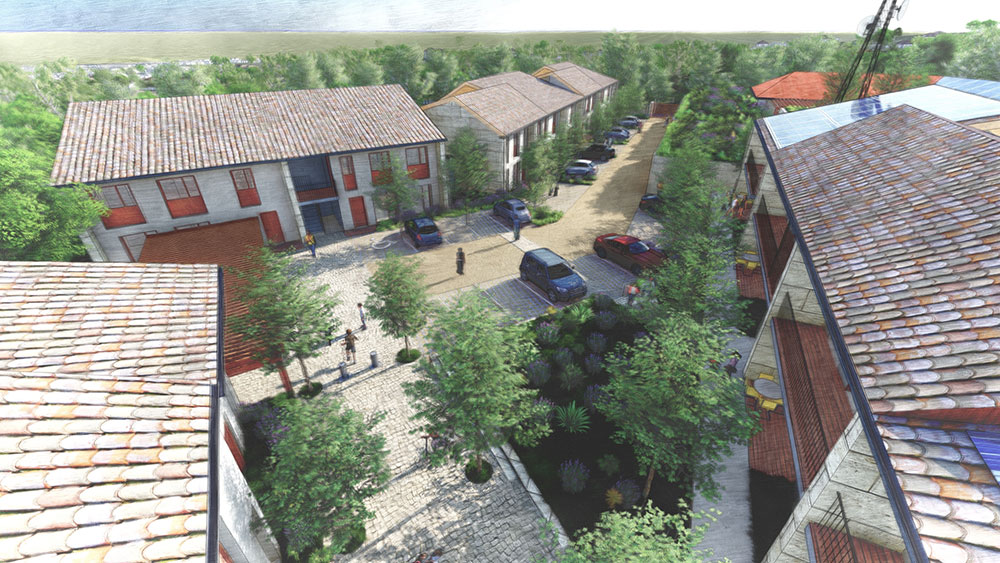
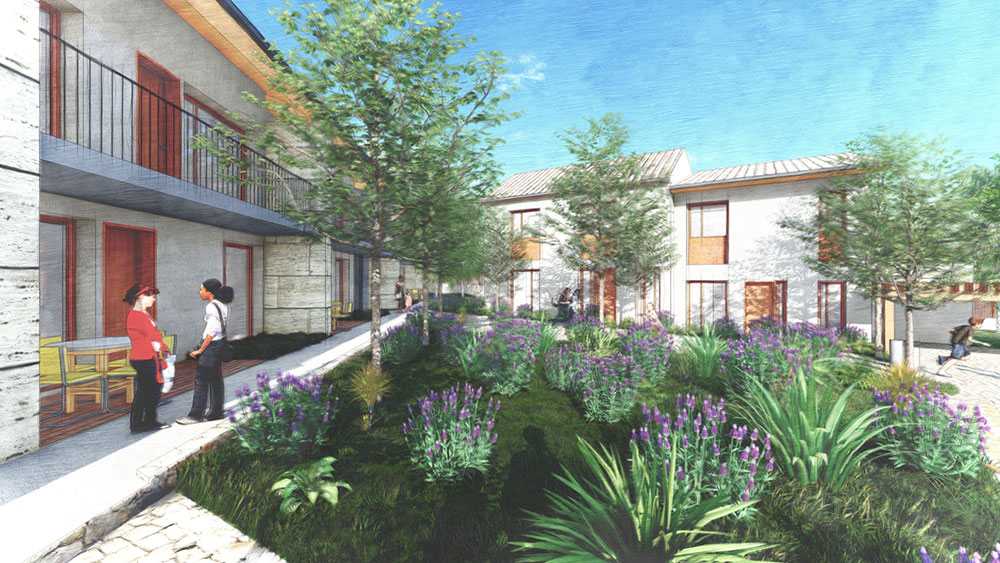
All visible facades of the gendarmerie (barrack) facing the public space will be clad in limestone, creating a massive and monolithic effect, emphasizing strength, much like the surrounding enclosure wall. The roof will be constructed of standing seam metal in ochre tone, blending subtly with the limestone color. Particularly, this architectural choice in roofing is driven by the durability of the structure, as we consider tiles too fragile for such a facility, vulnerable to intentional degradation or major weather events. The gendarmerie will be sheathed in limestone veneer, offering strength, nobility, and an institutional dimension to the building.
Controlled Boundaries for a preserved landscape
The gendarmerie project we present integrates perfectly into the municipality’s landscape through various scales of consideration: urban, constructive, typological, external aspects, materiality, lifestyles, and planted spaces. It is a project that we consider responsible, and which meets the announced challenges of this competition, namely: fulfilling its institutional functions, marking the city entrance, integrating into the typical local landscape, all while guaranteeing the comfort of users: gendarmes, families, or inhabitants of Venelles.
Local Architecture
In addition to its bioclimatic design, our project utilizes local, traditional bio-sourced and geo-sourced materials from the region, obtained through short supply chains. These materials resonate with the built landscape of the town of Venelles, leverage the expertise of local businesses, and contribute to the regional economy. Provence is a seismic territory characterized by predominantly mineral constructions.
Our project harmonizes with this architecture of light tones, presenting an albedo adapted to the local climate to ensure summer comfort. To ensure the robustness of the construction works, the buildings’ structure will be made of both massive stone for gable walls and shuttered concrete, adorned with traditional materials for facade walls and partitions.

All visible facades of the gendarmerie (barrack) facing the public space will be clad in limestone, creating a massive and monolithic effect, emphasizing strength, much like the surrounding enclosure wall. The roof will be constructed of standing seam metal in ochre tone, blending subtly with the limestone color. Particularly, this architectural choice in roofing is driven by the durability of the structure, as we consider tiles too fragile for such a facility, vulnerable to intentional degradation or major weather events. The gendarmerie will be sheathed in limestone veneer, offering strength, nobility, and an institutional dimension to the building.
Controlled Boundaries for a preserved landscape
The gendarmerie project we present integrates perfectly into the municipality’s landscape through various scales of consideration: urban, constructive, typological, external aspects, materiality, lifestyles, and planted spaces. It is a project that we consider responsible, and which meets the announced challenges of this competition, namely: fulfilling its institutional functions, marking the city entrance, integrating into the typical local landscape, all while guaranteeing the comfort of users: gendarmes, families, or inhabitants of Venelles.




